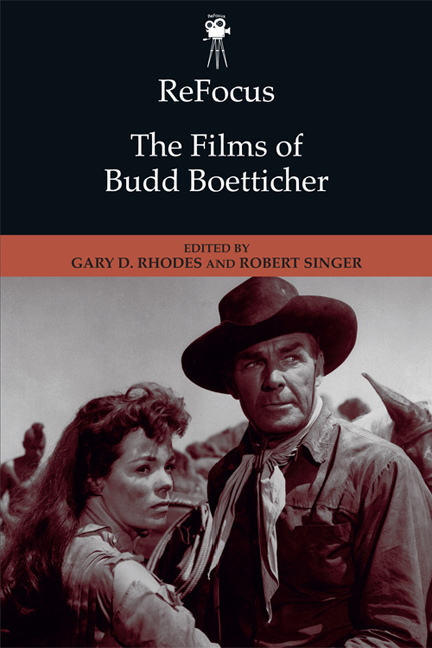Book contents
- Frontmatter
- Contents
- Notes on Contributors
- Dedication
- Introduction
- Part 1 The Non-Westerns
- Part 1 Introduction
- 1 “I never did think he was crazy”: Mystery and Criminality in Boetticher's Psychological Noirs
- 2 On Ethics and Style in Bullfighter and the Lady (1951)
- 3 Domestic Tension and Male Hysteria: The Killer is Loose (1956)
- 4 The Killer is Loose (1956) and the Televisual Dissolution of Film Noir
- 5 Adventures on the Small Screen: Boetticher, Warner Bros., and Maverick
- 6 The Signifying Heel: Boetticher's The Rise and Fall of Legs Diamond (1960)
- Part 2 The Westerns
- Index
1 - “I never did think he was crazy”: Mystery and Criminality in Boetticher's Psychological Noirs
from Part 1 - The Non-Westerns
Published online by Cambridge University Press: 22 December 2017
- Frontmatter
- Contents
- Notes on Contributors
- Dedication
- Introduction
- Part 1 The Non-Westerns
- Part 1 Introduction
- 1 “I never did think he was crazy”: Mystery and Criminality in Boetticher's Psychological Noirs
- 2 On Ethics and Style in Bullfighter and the Lady (1951)
- 3 Domestic Tension and Male Hysteria: The Killer is Loose (1956)
- 4 The Killer is Loose (1956) and the Televisual Dissolution of Film Noir
- 5 Adventures on the Small Screen: Boetticher, Warner Bros., and Maverick
- 6 The Signifying Heel: Boetticher's The Rise and Fall of Legs Diamond (1960)
- Part 2 The Westerns
- Index
Summary
No one was more dismissive of Budd Boetticher's early films than Boetticher himself. He disparaged them on numerous occasions in interviews, from calling working on them “a learning experience … I faked it” and even going so far as to say, “They were terrible pictures.” And, indeed, what limited critical treatment of Boetticher's work exists focuses on either his work with Westerns or bullfighting in cinema, rather than on his intriguing early forays into the war and mystery arenas. Two of the first ten films in Boetticher's canon are particularly worthy of further study, Escape in the Fog (1945) and Behind Locked Doors (1948). Both arguably films noir, these economical— both clock in at just over an hour—but expressive pictures reveal the early elemental precursors of what would become Boetticher's minimalist style and his interest in issues fundamental to the human condition, such as the negotiation between knowledge and mystery and the lines between the lawful and criminal.
Escape in the Fog, in true noir fashion, begins with a dream, a measure of unreality that will frame the entirety of the narrative. Eileen Carr (Nina Foch), a former army nurse, awakens screaming from this dream in a secluded inn, where she is recovering from a bomb attack. The dream sequence, which parallels a later and “real” sequence in the film, is shrouded in dense fog. Reviews of Escape in the Fog will often comment that this proliferation of fog, though expertly used, is perhaps the only stylistic mark of note in the film. Indeed, Boetticher spares no use of the fog machine in these scenes, creating an obfuscated atmosphere of uncertainty and dread. In both scenes, Carr is walking on the Golden Gate Bridge, San Francisco, where she meets a policeman who initially suspects that she is contemplating suicide, and cautions her about walking there alone: “You never can tell what'll come outta the fog.” And this warning proves to be true, as Carr witnesses a car pulling up near her, men falling out of it struggling, and one of them getting shot, whereupon the dream ends. Mark Osteen notes: “noir dreams stage ruptures in identity and integration that are not just individual but collective.”
- Type
- Chapter
- Information
- ReFocus: The Films of Budd Boetticher , pp. 15 - 27Publisher: Edinburgh University PressPrint publication year: 2017



